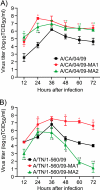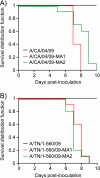Adaptation of pandemic H1N1 influenza viruses in mice
- PMID: 20592084
- PMCID: PMC2918990
- DOI: 10.1128/JVI.00159-10
Adaptation of pandemic H1N1 influenza viruses in mice
Abstract
The molecular mechanism by which pandemic 2009 influenza A viruses were able to sufficiently adapt to humans is largely unknown. Subsequent human infections with novel H1N1 influenza viruses prompted an investigation of the molecular determinants of the host range and pathogenicity of pandemic influenza viruses in mammals. To address this problem, we assessed the genetic basis for increased virulence of A/CA/04/09 (H1N1) and A/TN/1-560/09 (H1N1) isolates, which are not lethal for mice, in a new mammalian host by promoting their mouse adaptation. The resulting mouse lung-adapted variants showed significantly enhanced growth characteristics in eggs, extended extrapulmonary tissue tropism, and pathogenicity in mice. All mouse-adapted viruses except A/TN/1-560/09-MA2 grew faster and to higher titers in cells than the original strains. We found that 10 amino acid changes in the ribonucleoprotein (RNP) complex (PB2 E158G/A, PA L295P, NP D101G, and NP H289Y) and hemagglutinin (HA) glycoprotein (K119N, G155E, S183P, R221K, and D222G) controlled enhanced mouse virulence of pandemic isolates. HA mutations acquired during adaptation affected viral receptor specificity by enhancing binding to alpha2,3 together with decreasing binding to alpha2,6 sialyl receptors. PB2 E158G/A and PA L295P amino acid substitutions were responsible for the significant enhancement of transcription and replication activity of the mouse-adapted H1N1 variants. Taken together, our findings suggest that changes optimizing receptor specificity and interaction of viral polymerase components with host cellular factors are the major mechanisms that contribute to the optimal competitive advantage of pandemic influenza viruses in mice. These modulators of virulence, therefore, may have been the driving components of early evolution, which paved the way for novel 2009 viruses in mammals.
Figures




References
-
- Bovin, N. V., E. Y. Korchagina, T. V. Zemlyanukhina, N. E. Byramova, O. E. Galanina, A. E. Zemlyakov, A. E. Ivanov, V. P. Zubov, and L. V. Mochalova. 1993. Synthesis of polymeric neoglycoconjugates based on N-substituted polyacrylamides. Glycoconj. J. 10:142-151. - PubMed
-
- Brown, E. G., and J. E. Bailly. 1999. Genetic analysis of mouse-adapted influenza A virus indentifies roles for the NA, PB1, and PB2 genes in virulence. Virus Res. 61:63-76. - PubMed
-
- Centers for Disease Control and Prevention. 2009. Swine influenza A (H1N1) infection in two children—Southern California, March-April 2009. MMWR Morb. Mortal. Wkly. Rep. 58:400-402. - PubMed
Publication types
MeSH terms
Substances
Grants and funding
LinkOut - more resources
Full Text Sources
Other Literature Sources
Medical
Miscellaneous

